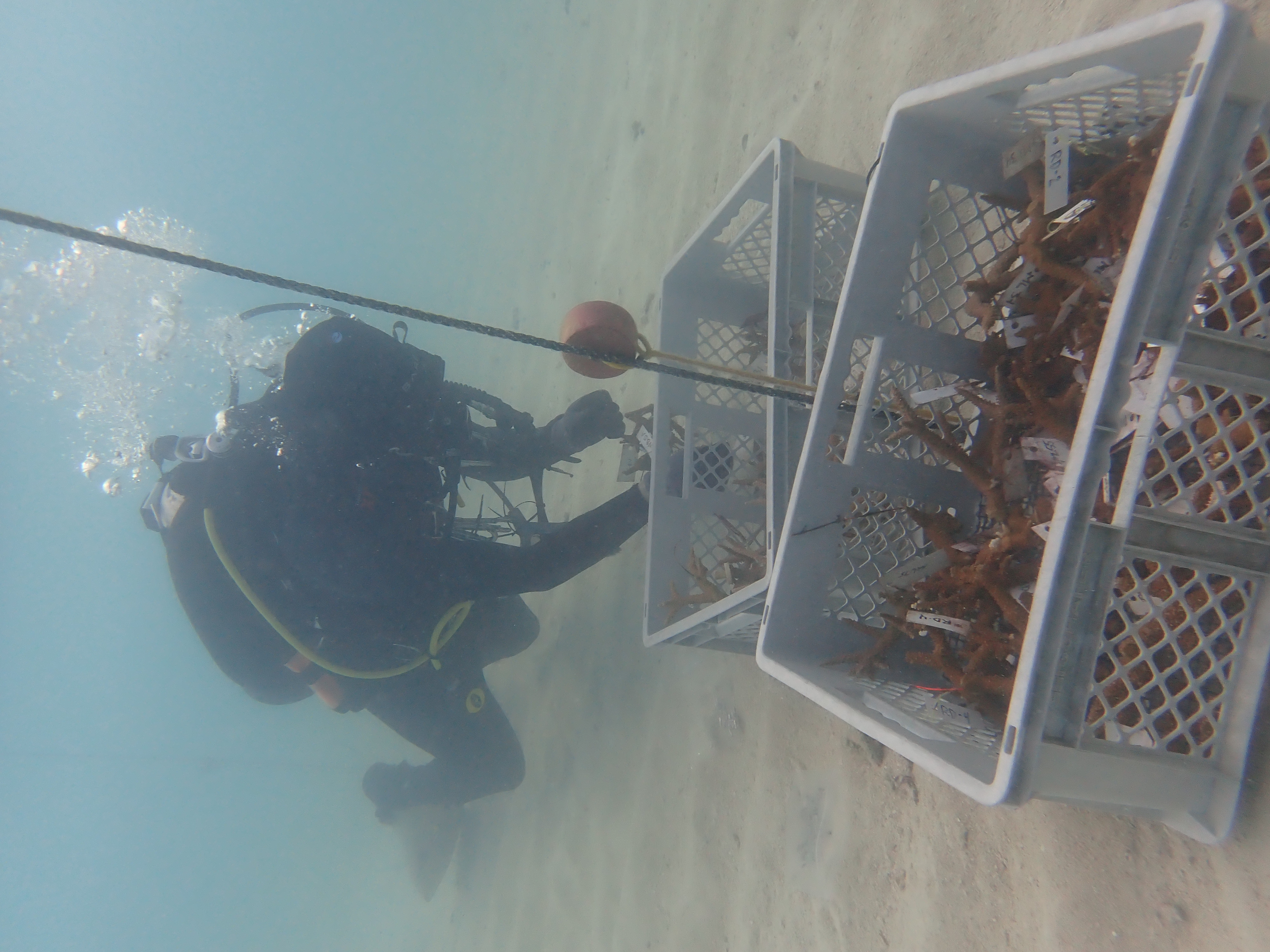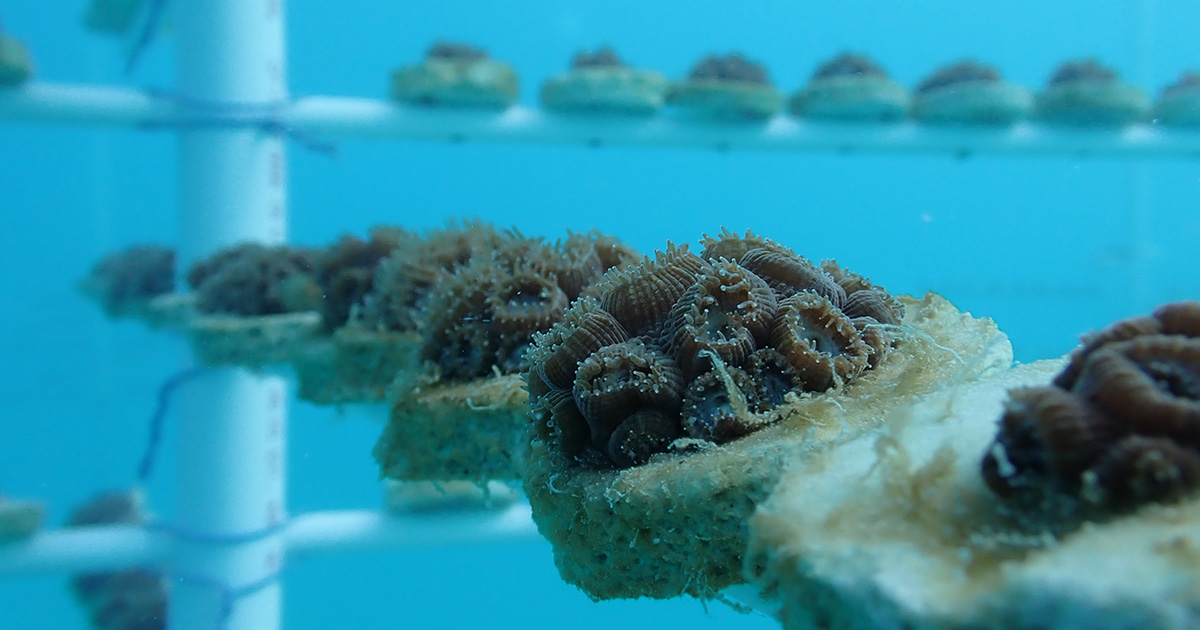Mote Marine Laboratory’s team of expert coral reef restoration researchers have begun the multistep process of reintroducing thousands of healthy corals back into its underwater nurseries after recovering at Mote’s land-based facilities during this summer’s unprecedented thermal stress event.
The return effort comes almost three months after Mote began an unprecedented, herculean evacuation of thousands of stressed and dying coral from its four offshore coral nurseries due to a significant coral stress event that included a record-breaking heat wave compounded by both higher-than-normal salinity and low oxygen water from Florida Bay.
“While heat and stress events themselves are not uncommon, this was the first time we had experienced a stress event that included thermal stress in combination with other stressors such as high that developed so quickly, in such an intense magnitude,” said Dr. Jason Spadaro, Mote’s Coral Reef Restoration Research Program Manager. “We’re certainly glad this particular stress event is over, but we’re still in the process of collecting data and learning as much as we can from this event to further improve upon Mote’s holistic coral reef restoration approach to ensure the best future for our coral reefs.”
Global, regional, and local stressors have significantly contributed to the decline of our coral reef ecosystems, most notably in Florida and the Wider Caribbean Region. Living coral cover (the proportion of the reef covered in living coral) on Florida’s Coral Reef is currently between just 1 and 5 percent, dramatically less than just 40 years ago when it was more than 30%. Many factors make a natural recovery of Florida’s Coral Reef unlikely and nearly impossible on a timescale relevant to humans. The recovery of function on Florida’s Coral Reef is likely now entirely dependent upon adaptive management and pro-active science-based restoration.
The Coral Stress Event of 2023
Florida’s Coral Reef experienced record-breaking heat waves starting in July 2023, with temperatures in adjacent backreef areas reaching temperatures above 100°F. When waters stay too hot (>87 degrees F) for too long, many corals in Florida, and around the world, become stressed and can expel the symbiotic algae, called zooxanthellae, living inside their tissues. These algae give coral its beautiful color, but they also provide the coral with food. Without it, corals appear white, as if bleached (hence the term coral bleaching) and could potentially die if the stress persists for too long. The heat, coupled with high salinity and low oxygen, presented an unprecedented stress event that took its toll on coral reefs and coral fragments in offshore nurseries.
With the help of over 70 staff members, six Mote research vessels, and immense support from the Keys community, Mote was able to quickly and carefully transport thousands of stressed and dying corals from its offshore nurseries in Sand Key, Looe Key, Islamorada, and Key Largo, in a matter of days to its three land-based coral nurseries on Summerland Key, Key Largo, and Islamorada, as well as to its 200-acre Sarasota-based Mote Aquaculture Research Park (MAP).
By late August, Mote had taken in thousands of pieces of coral. Among those brought in were several endangered species, including Staghorn and Elkhorn coral, as well as other major reef building boulder, brain, and star corals.
However, Mote strategically left a small subset of genotypes from several species in its offshore nurseries to put them to the test and, even after they were exposed to the stress event, some not only survived, but they also thrived.
“While we lost coral in this event, we also witnessed coral that, despite the intense stress event, survived, thrived, and some that never even bleached. These coral, these are ones we want to pay particular attention to as we look to the future of science-based coral reef restoration,” said Dr. Spadaro. “While this was incredibly devasting in a lot of ways, we’re finding silver linings that point to successes in Mote’s science-based restoration methods.”
What’s Next
Expert staff worked diligently to aid in the recovery of the evacuated stressed and dying corals, and as of Oct. 21, 2023, Mote scientists have begun to slowly return the thousands of surviving evacuated coral back into its offshore nurseries.
“Mote has invested in science-based coral reef restoration and research for over 30 years in the Florida Keys and around the world. As a result, we were equipped with the land-based infrastructure and highly experiences science staff to provide tens of thousands of corals a safe place to grow until conditions improved on the reef,” said Dr. Michael P. Crosby, Mote President & CEO. “We are happy to report that conditions have now improved, and we can safely begin the strategically methodical multistep process of reintroducing these corals back into our underwater nurseries where they will continue to be used in Mote’s holistic coral reef restoration effort.”

Mote is following strict protocols outlined by the National Oceanic and Atmospheric Administration (NOAA) and the Florida Fish and Wildlife Conservation Commission (FWC) as the corals are returned to Mote’s offshore nurseries. These protocols include a requirement for a veterinarian health certification of all of the evacuated corals before they can be returned to offshore nurseries. The corals are closely examined for any potential diseases or pests that could spread on the reef. Once cleared and reintroduced to the offshore nurseries, the corals undergo a strict 30-day observation period before they are reassessed by Mote staff and subsequently cleared for restoration purposes such as microfragmentation and eventual outplanting onto Florida’s Coral Reef.
Microfragmentation refers to the act of cutting the coral into small pieces to create genetically identical duplicates that grow as much as 50x faster than a natural coral.
Using resilient coral genotypes in Mote’s innovative microfragmentation and fusion methodology allows Mote to grow thousands of coral fragments rapidly, which when outplanted on degraded reefs will become sexually mature corals in a fraction of the time it would take for natural corals.
Mote researchers have already begun to take the next steps toward increasing its coral fragment abundance using, in many cases, its microfragmentation method. Mote estimates that normal coral restoration and outplanting operations on Florida’s Coral Reef will resume early in 2024.
“The immediate goal for us is to continue to gather and analyze data from this most recent stress event, apply what we’ve learned to future data-driven restoration techniques, and use our proven microfragmentation techniques on the species and genotypes that we know did well during this event. These resilient individuals, along with representatives of the natural diversity of Florida’s Coral Reef will be used to rebuild our offshore nurseries with resilient corals that can later be used for outplanting and other restoration methods. These diverse and resilient corals will pass those traits on to the next generation of resilient corals on Florida’s Coral Reef,” said Dr. Spadaro.



